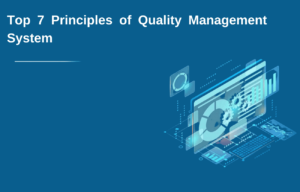Principles of Quality Management System: Quality planning, assurance, control, and improvement are the four primary parts of quality management. To hold them to a high and consistent level, quality management monitors the activities, tasks, and processes (inputs) utilised to produce a product or service (outputs). Total Quality Management is putting all four components into operation inside a company.
Quality Management (and TQM) places equal emphasis on the tasks and procedures that go into producing the outputs (products and services) as it does on the value of the outputs. Achieving more consistent, higher-quality goods and services is ideal for both the quality of an item and service and the method by which it is produced to be improved. Four essential elements make up quality management, including the following:
- The process of determining the quality criteria that apply to the project and how to satisfy them is known as quality planning.
- Quality improvement is the deliberate modification of a procedure to raise the certainty or dependability of the result.
- Quality control is the ongoing endeavour to maintain the dependability and integrity of a process in producing an outcome.
- The systematic or planned efforts required to provide enough dependability so that a specific service or product will fulfil the stated requirements are known as quality assurance.
What is Quality Management System (QSM)
Would you like to see increased productivity and reduced waste in your business? How about fewer client grievances? A quality management system (QMS) is the answer you’re looking for. Unfortunately, because quality management systems are so complicated, many businesses need help putting them into practice.
A quality management system (QMS) is a group of operational practices and guidelines that tries to guarantee that the quality of delivered goods and services meets or surpasses client expectations. Quality management systems, which are defined as a framework of well-organised structures, methods, strategies, policies, practices, processes, and resources, are also ways by which businesses can make sure that obligations, timetables, relationships, contracts, and agreements adhere to climate, food, and product safety standards. Such systems depend on continuous improvement and are often scalable and measurable.
Benefits of using a Quality Management System
Have you got a quality management system that your business can bank on? A brilliant system that assists you in beating your rivals in the race? If not, you are daily losing both money and clients. Although you have a great product, your rivals are one step ahead. Although you have devoted customers who want to do business with you, your rivals take just a few more from you monthly. What could be wrong, you ponder now? Your marketing plan, product, and customer relations are excellent. Even when you try a different strategy, your Return remains the same.
What if I told you that your business needs to implement a Quality Management System (QMS) to keep your rivals on their toes? It will let you specify how your business intends to manufacture, record, manage, and deliver your goods and services in a way that satisfies your client’s needs. An important advantage of a quality management system is the potential for ongoing development. Monitoring client happiness is necessary to identify the areas of the business that require improvement today and in the future.
You’ll be better able to determine what modifications need to be done to ensure client satisfaction by standardising and documenting this process. In the long term, this will save you time and money by reducing client complaints and returns. A quality management system’s significance could be more recognised. Many organisations mistakenly believe that large corporations are the only ones who need a quality management system. Any size organisation in any industry can gain from using a quality management system.
A quality management system enables businesses to maintain continuous improvement, establish regulatory compliance, and ensure that quality is incorporated into every phase of the good or service. Increased client happiness, loyalty, and repeat visits follow from this.
- Enhanced goods and services: A quality management system ensures that standards are kept throughout the whole life cycle, from creating products and services to consumer use and after-sale customer care.
- A rise in productivity: Working with a cutting-edge quality management system guarantees that staff members adhere to the most recent standards set out, which helps process effectiveness, quality, and time management.
- Increased dedication from employees: Clear obligations and responsibilities in the area of assurance are made possible through quality management systems. The quality and success of the company are enhanced by this transparency, which also enhances private communications between the departments or teams of the business.
- Better adherence: Companies can ensure that their procedures adhere to (international) standards and laws quickly and easily by implementing a quality management system that includes documentation systems.
Also Read: Major Decision Areas In Supply Chain Management
Additionally, such systems make it possible to conduct audits and generate reports, which makes it simpler to ensure that it complies and makes adjustments as necessary.
- Consumer contentment—Because a well-designed and executed quality management system relies on industry-leading client requirements and expectations, businesses can improve customer service by incorporating such best business practices.
- Enhanced procedures—A secondary benefit of quality management systems is that they encourage companies to regularly review their operations and products. The possibility to identify (additional) areas for improvement presented by this activity allows for the generation of added value.
Limitations of Quality Management System
The requirement for and difficulty in obtaining a company-wide commitment to quality improvement is one of the key disadvantages of the quality management system. Because any lack of effort or resources will jeopardise the performance of the quality management programme and hurt the entire organisation, all levels of management checks should be in place.
Management’s half-hearted efforts are doomed to failure unless a quality management system is completely implemented. For instance, restricting the project to staff training alone without using statistical methods to gauge and assess process improvements would lead to dissatisfaction and poor outcomes. With assessments and quantified results, training programmes must be brought full circle. Some businesses prioritise training because it is observable and simple to demonstrate that action was taken. However, the information and abilities learned in training are likely to remain if they are supplemented with regular coaching.
- Hindrance in production – To create an appropriate quality management system, employees must rigorously teach their staff. Although the changes shorten lead times, decrease waste, and boost productivity, the initial phases of introducing quality management in a company might result in lower worker productivity.
- Employee Resistance – It takes new ways of thinking, approaching problems, and working to develop a quality management system. When management fails to adequately explain the quality Management system, employees may suffer fear, leading to employee resistance. Employee morale and productivity for the company may suffer if employees rebel against the programme.
- Reduces Creativity – The emphasis of the quality management system on task standardisation to guarantee consistency discourages innovation and initiative. It also hinders fresh concepts that can increase productivity.
Related Learning: 14 Principles of Management
Seven Principles Of Quality Management System
Every successful company places a strong emphasis on quality. But you need a clever plan if you want consistent quality. You can get a road map to improve product and service quality through a quality management system. Businesses with a quality management system frequently need more focus, direction, and a consistent level of product quality. Any comprehensive program must include the following principles of the quality management system we discuss here.
- Consumer Focused – Customer focus is essential to quality management principles, as the title says. Focusing on both direct and indirect clients is the principles of quality management system. Your objective should be to both meet and surpass client expectations. By concentrating on customers’ demands, the goal is to achieve ongoing success. Value-added services must be offered at every stage. Focusing on the consumer requires managing customer connections and keeping an eye on client satisfaction is what the quality management system stands for.
- Leadership – The quality management system of a company will only succeed if the leaders support it and make it a strategic priority. Because of this, leadership is listed as the second principle of quality management in ISO 9001. The organisation’s leadership must be committed to a quality management system. Strong leadership includes the C-suite and other supervisors establishing the company’s quality management system and fostering a culture of quality from the top to down. Businesses will achieve quality management objectives with a strong leadership vision and a budgetary commitment.
- Participation of people: – Staff engagement is made possible by recognition, empowerment, and competency improvement as the entire team works to accomplish the goals of a quality management system. A quality management system has a higher chance of success when all employees are involved at all levels of the organisation, and their voices are heard. Before transitioning your organisation to a quality management system, give workers time to prepare. Doing so guarantees benefits in productivity and effectiveness.
- Process strategy – The term “process approach” describes the idea of viewing a firm as a collection of connected processes instead of isolated departments or blocks. Instead of concentrating on specific roles, team divisions, and other permanent components, it means emphasising the dynamic business processes. This systematic approach promotes productivity, assists with improved resource allocation, and supports consistency when team members depart and need to be replaced. These elements work together to improve the quality management system and make the company more adaptable to react rapidly to market developments.
- Improvement – When it comes to quality management systems, businesses never “arrive” or completely accomplish their objectives. This idea states that they should fight boredom and maintain a constant emphasis on improvement which is what the principles of quality management system refer to. Businesses committed to a quality management system will set another, more ambitious goal when they accomplish their first one, so the conceptual boundaries are never static.
- Decisions based on evidence – Make sure your workers evaluate the available data and information before making decisions. Give the decision-makers in your organisation access to important details to promote the principles of quality management system. Having access to reliable data enhances the decision-making process. Additionally, it enhances your company’s capacity to examine and modify judgements or viewpoints. It also enables you to assess the success of previous choices.
- Relationship administration – Consider if relationship management sounds more important to sales than a quality management system. Maintaining positive connections with all parties involved is a requirement of the principles of quality management system, including suppliers, vendors, and distributors, in addition to customers. The key to accomplishing quality objectives is building trusting connections with these external partners and helping them to realise the vision for the quality management system.
Challenges Faced While Developing Quality Management System
The establishment of a quality management system might occasionally provide difficulties. The misperception that a quality management system primarily refers to the procedures required to deal with the examination and disposition of non-conforming products, frequently assigned to members of a quality control department, is one of the first obstacles to be overcome. Such a system essentially examines the quality of the product or service by managing only the product inspection and not the inputs that allow a product or service to be compatible in the first place.
The underlying policies must be created and conveyed to all levels of the company to demonstrate management’s commitment to the quality Management System. The quality management system can then be used as a way to ensure that all essential services are defined, met, and improved.
Also Read: What is the difference between logistics and supply chain management?
Core Elements Of Quality Management System
Even though quality management systems might vary based on the type of business, all quality management systems have a few fundamental components.
The following nine components make up a quality management system:
- The management‘s quality policy is a broad statement that gives the quality management system direction. Precise quality objectives and quantifiable targets support the quality policy.
- The quality manual is a publication that gives an overview of the quality management system. It contains details on the quality management system, such as the quality policy and objectives.
- The organisational structure provides the quality management system’s framework. Within the organisation, it outlines each person’s duties and obligations.
- Data collection, storage, and analysis are what this involves. Data can help attempts to improve the quality of products.
- The actions taken to accomplish quality goals are referred to as processes. Buying is the process of obtaining goods, services, and supplies.
- The extent to which a product satisfies its quality goals is referred to as product quality. Customer satisfaction measures how happy customers are with a product’s quality.
- Continual development is continuously enhancing quality by implementing minor, incremental adjustments. Corrective and preventive action (CAPA) is a procedure for dealing with quality concerns and averting future quality difficulties.
- Quality instruments comprise calibration and testing equipment, which must be kept in excellent condition to assure accuracy. Quality instruments are tools used to quantify quality.
- Controlling documents The process of creating, examining, and authorising papers is known as document control. Controlling documents is necessary to make sure they are correct and current.
Leading examples of Quality Management
- Toyota Corporation’s use of the Kanban method is a prime example of an excellent quality management system. By giving suppliers and customers visibility, Taiichi Ohno devised the inventory control method known as kanban, which helps to prevent the accumulation of surplus stock on the manufacturing line at any time. Toyota implemented the idea in their Just-in-Time (JIT) system, which aids in coordinating supplier orders for raw materials immediately with the production schedules. The productivity of Toyota’s production line rose because the corporation had just enough inventory on hand to fill orders from customers as they came in.
- Ford Motor Company employs a quality management system to identify and gratify customers’ needs. Ford Motors has elevated itself to prominence in the US automobile sector by implementing the quality management system concepts. Ford implements many quality management systems in its operations to guarantee high-quality goods and client happiness, which fosters brand loyalty and enhances the business’s overall reputation. Ford adheres to the quality management system of customer-centricity, continuous improvement, employee empowerment, supplier quality management, and high-quality product design.
The bottom line
Customer satisfaction is crucial in business, and so is the art of understanding how to deliver it. The quality of the goods or services a customer purchases should always be the supplier’s priority because this is what the buyer is most concerned about when making a transaction. For a company to maintain consistency across all its processes, and deliver top-quality products and services, diligently following the quality management system is essential. To learn more about the principles of quality management system, Advanced program in Supply chain strategy and operations management is the key!
More Information:
Know Essential Components Of Supply Chain Management
Objectives Of Supply Chain Management Explained




























